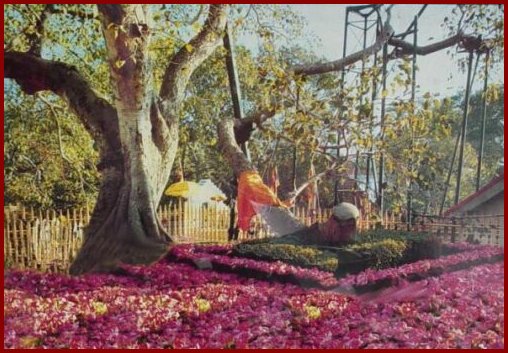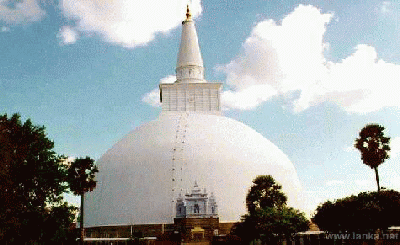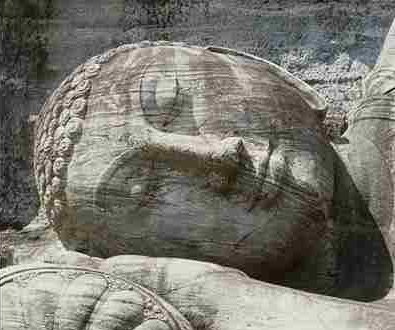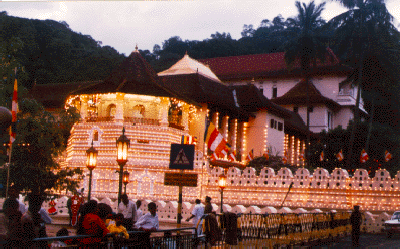
ANCIENT BUDDHIST SHRINES
IN
SRI LANKA


Jaya Sri Maha Bodhi, Anuradhapura
A branch of the Sacred Bodhi tree under which
Gautama the Buddha attained enlightenment
which was brought to Sri Lanka in the third century B.C.
"In Sri Lanka, there grows to
this day, a tree,
the oldest historical tree in the world which we know
certainly to have been planted as a cutting from the
Bodhi tree in the year 245 B.C."
H.G.Wells
World renowned British Historian

Ruwanveliseya
Dageba, Anuradhapura.
Anuradhapura was the first capital of Sri Lanka. This majestic
dageba 300 ft. in diameter was constructed by King Dutugemunu
(167-137 BC), the first great hero of the Sinhalese. King Dutugemunu
was, however, unable to complete the work on the dageba.
Broad
flights of steps are found at the entrance of the sand strewn
courtyard of the dagoba. The retaining wall was covered with figures
of elephants in frontal aspect represented as standing cheek by jowl.
At the four cardinal points of the dageba are four "vahalkadas"
(frontispieces) which have preserved some very old sculptures.
Work on this dageba has been done time and again after the day of
King Dutugemunu. The Mahavansa records that the 3 floral terraces
were encased in stone work in the reign of Lajjitissa (119-109 BC).
Gal
Vihara, Polonnaruwa.

Potrait of reclining Buddha, Polonnaruwa
Polonnaruwa was the capital of Sri Lanka from the eleventh
century A.D. This
site is also known as the Uttharama by virtue
of the fact that it is situated to the North of the Mediaeval city.
As the statues have been carved out of the living rock it is known
as the Galvihara. In the excavated cave here, known as the
Vijjhadhara Guha is a statue in the Samadhi mudra. Beside the
cave on the flat surface of the rock is inscribed the set of
monastic
rules promulgated by King Parakkramabahu I (1153-1186 AD)
and known as the Katikavata.

Sri Dalada Maligawa, Kandy
Sri Dalada Maligawa, which enshrines the Tooth Relic of the Buddha,
is one of the holiest shrines in the entire Buddhist world. The
Tooth Relic
was brought to Sri Lanka by a princess from Kalinga named Hemamali,
securely wrapped in her tresses, when King Kirti Sri Meghavarna
(301-328) was ruling in Anuradhapura. By the 12th century the
Tooth Relic had become the palladium of Sinhala royalty, conferring
on its custodian the right to the sovereignty of Sri Lanka. Hence
the
kings took every precaution to guard it. When the capital shifted
from Anuradhapura to Polonnaruwa, one of the earliest buildings to be
erected by Vijayabahu 1 (1055 - 1100) was the Dalada Maligawa.
Parakramabahu 1 (1156 - 1183) and Nissanka Malla (1187 - 1196)
both of Polonnaruwa are known to have built magnificent edifices to house
the Tooth Relic. The capitals changed from Polonnaruwa to Dambadeniya,
Yapahuwa to Krurunegala and Kotte and in each of these places the first
duty of the king was to build a Dalada Maligawa surpassing in grandeur
the royal palace, but in close proximity to it.
When Kotte fell into
Portuguese hands the monks fled the city carrying
the Relic which they kept hidden in a secret place. With the accession
of Wimala Dharma Suriya 1 (1592 - 1604) in Kandy a new dynasty arose.
After his victory Wimala Dharma Suriya 1 built the two storeyed
Sri Dalada Maligawa and brought it to Kandy in great ceremony.
There it lies, attracting the piety and veneration of Buddhists
all over the world.